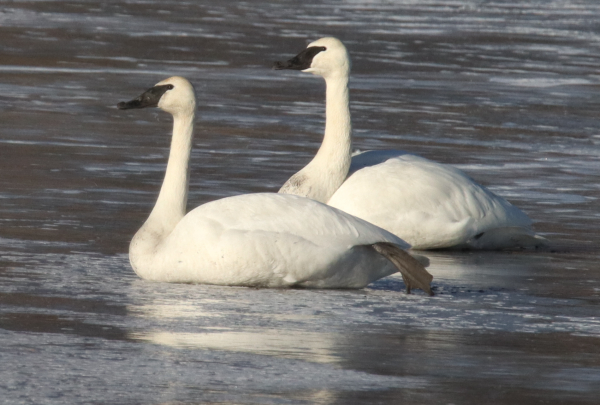
A resting pair of Trumpeter Swans seemed to be laying claim to a large Minnesota marsh, even if it was in a subtle way.
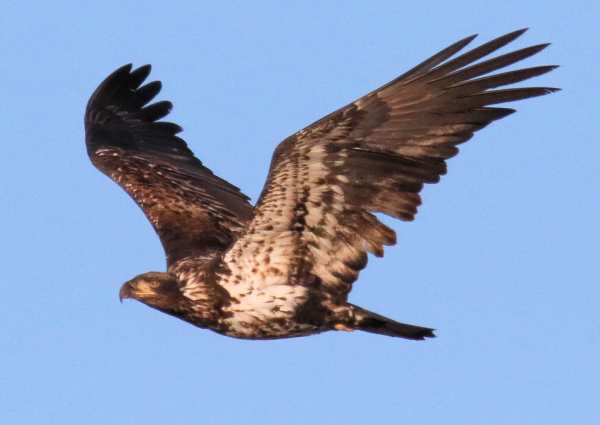
An abiding yearling Bald Eagle provided an opportunity to photograph its flight – the only immature eagle observed during a day of 12 Bald Eagle sightings.
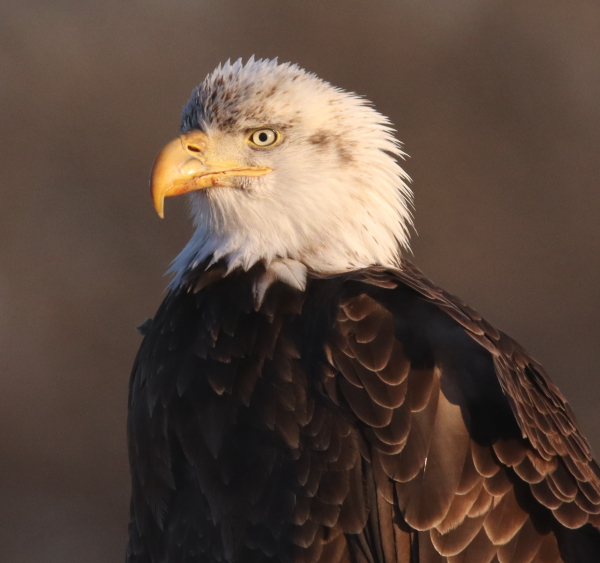
An especially trusting Bald Eagle permitted some portrait photos as it watched over another eagle feeding on the ground.

Appreciating this unique concentrated look of the same Bald Eagle, I hesitated sharing it without showing the preceding image with it; they tend to complement one another.
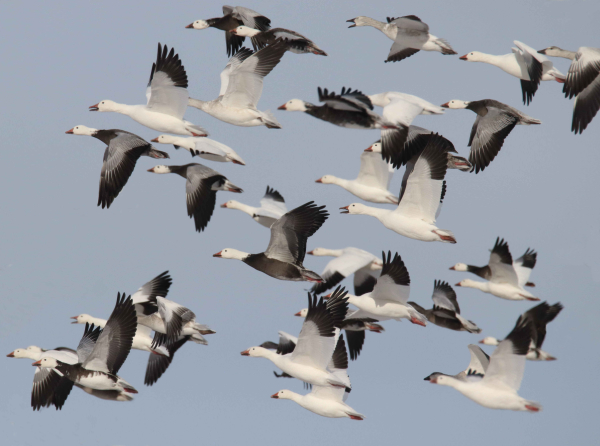
The first sightings of Snow Geese are always a time to celebrate as a breakthrough moment of spring. This flock had a high percentage of blue morph Snows.
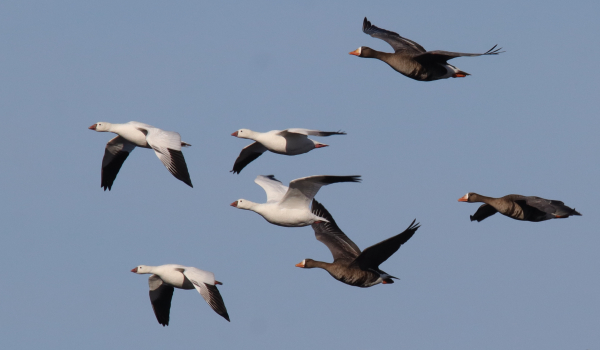
By Monday, a few Ross’s Geese and White-fronted Geese mixed into feeding flocks. Soon 5 species of geese will surround The Birding Wire office.
|
For a special change of birding venue, a day trip into Minnesota lakes country would be my first visit to the eastern woodland and lakes biota this year. It still had vestiges of winter, with leaf-bare trees and ice-covered lakes and marshes the rule. But the winter snow was gone and the mega-birds were active, with a few Bald Eagles attending nests and some Trumpeter Swans scoping out pre-season nesting territories, while both species were actively seeking out area foods. I’ve been wanting to check out the Trumpeter Swans in the Pelican Lake area and Thursday was the day.
My friend Andy told me about the 25 or so Trumpeter Swans that were gathering along open water on one side of his lake property several weeks ago, but the intense February cold period held up my visit. After checking to see if Andy was free to get together the night before, I headed across the eastern third of North Dakota, observing 2 Bald Eagles along the way – 1 soaring along the James River and another in a hunting flight above the Red River. There was also a Northern Shrike and 4 male Ring-necked Pheasants, although the pheasants were observed as 1, 1, and 2, all within 20 miles after leaving home.
Just as the landscape changed from the Great Plains to the Eastern Woodlands, Trumpeter Swans began to appear in groups of 2 and 3. A nice Red-tailed Hawk with a distinct belly band was evident roadside and 4 single adult Bald Eagles appeared along the way, including 1 perched next to a nest and 1 landing on a nest and inspecting the platform.
By the time I reached a vantage point to take a look at the open water area adjacent to Andy’s lake home, the calm water held no swans at that time; but a pair of Canada Geese flew into the open water area and landed. There was also a pair of Bald Eagles perched on a shoreline tree on the other side of the river from Andy’s house (the east side of his property faces the lake, and the south side borders the little river that flows to the next lake). Only the pair of geese was present by the time I met Andy in his yard, so we made a plan to check the river where it flows into the lake – a location where Andy’s friends Craig and LaRae live.
Indeed, there were 21 Trumpeter Swans there, but they were at the edge of the ice or swimming in the open water between us and the sun. Even so, the yard was full of Black-capped Chickadees and it was nice to hear the wild calls of the swans, sometimes mixed with the 24 Canada Geese scattered among the swans. From there we checked another open water area, and continued through the back roads southwest of Detroit Lakes, seeing occasional pairs of Trumpeter Swans and Canada Geese along the way, including a pair of Trumpeters that was resting on the lake ice of a familiar marsh near our friend Linda’s lake home. I walked up a little hill to a vantage point where I photographed the swans as they raised their heads upright.
Andy and I had a great visit as we cruised the back roads, and on our way back I spied an adult Bald Eagle about a mile ahead, perched on a low fence post next to the road. As we cruised closer Andy saw there were 2 more adult Bald Eagles even closer to the road! That’s when I realized there was a car behind us, the first we’d seen in several miles, so I couldn’t pull over and had to continue driving past the eagles. To our surprise the eagles didn’t flush, and Andy had a really close view as we passed within a few feet of the threesome, as did the car behind us. After about a half-mile I was able to turn onto a side road to turn around and give the eagles another drive-by so I could get on the sunny side of them to photograph.
This time as we passed, 1 of the eagles flew from the roadside, where there was a roadkill that attracted the eagle’s attention. With no cars to be seen or heard along the entire stretch of road – a mile to the east and 2 miles in the west – I turned around to get a photo op. The eagles continued with their roadside action as 1 was feeding on the ground and the other was perched on the fence post. We both appreciated the excitement of the moment as I began photographing 1 eagle, then the other, and back again. While we were in position, Andy counted 6 eagles within view as other eagles flew in from the woods and from beyond a nearby hillside.
The only young eagle encountered that day was a light-colored yearling that was abiding enough to fly in our direction, allowing me to photograph it as it winged across the clear blue sky. It was a fun opportunity that Andy appreciated as much as I did, and after photographing the relatively inactive adults, this beautifully marked yearling provided a nice series of flight photos. To see more photographs from that interaction, you can refer to the Bird Photography article in this issue.
A Spring Breakthrough
Awaiting a major push of geese and ducks near home, by Saturday evening I was a bit surprised that waterfowl hadn’t materialized yet, but there were a few scattered birds of prey to add a little excitement to local birding drives. Wednesday I observed a Merlin on a low hunting flight, and a male Northern Harrier materialized in a low hunting flight Friday, but that was pretty light fare for the second week of March. Pretty disappointed as I returned from a bird-less search to the north, west, and south Saturday afternoon, I conceded that the vanguard of geese could arrive at any moment – morning, noon, or night. A week of warm temperatures in the 40s and 50s may make the difference as area marshes thaw little by little.
A White-breasted Nuthatch broke my concentration while writing Sunday morning, and reminded me to fill my platform feeder with shelled sunflower seeds and shelled peanut halves. As I opened the front door, I could barely believe I was suddenly seeing complex lines of Snow Geese flying low overhead, just above the tree tops, filling the spring air with vibrant goose music – Hoooray! I watched and listened as the hundred-plus geese flew into the stout west-northwest wind, followed by another flock approaching from the south.
That gave me the impression the area must be filled with geese on the wing, so I drove into the open to scan the sky in 3 directions, but just 1 other flock of about 20 Snows was in the sky. I drove a mile east, then a mile south – where I encountered 2 more flocks of Snow Geese in flight, quite a bit higher than the others. I continued another 7 miles south, but didn’t see another flock. But that was the big breakthrough, the first crack in the dam, the first geese surging across the border (from South Dakota or maybe Nebraska).
With strong winds blowing from 20 to 30mph Monday afternoon I didn’t expect new migrants to appear, but as I was working on this issue a long line of Snow Geese filled the view from my bay windows about 2:30, flying north into the wind – and they kept coming in an almost continuous movement low overhead. I stood in my bay addition and opened a window to hear the goose music better as the Snows passed overhead for more than 2 minutes. I decided not to follow them, or look for more in the area, but about 5:15 I noticed a couple small flocks flying from east to west a distance to the south.
This time I followed, and watched as they landed in a harvested cornfield about a half-mile west-southwest of my windows. The white and blue Snow Geese stood out, numbering about 100, but it was doubly exciting to see groups of White-fronted Geese among the Snows, the first of spring. I took a few photographs in spite of the mostly cloudy sky, but I’m glad I did because my photos revealed several Ross’s Geese mixed among the Snows – that’s the best way to detect Ross’s Geese, sometimes the only way.
There were a few hundred more geese feeding a mile farther southwest, which I could see while observing the initial feeding flock, and I checked the sky to the north and saw 2 small flocks of White-fronted Geese, and a separate flock of a couple hundred Snow Geese (probably with some Ross’s Geese interspersed too). Another first of the year were the Mallards I observed swimming in a bit of open water on the edge of Dean’s Lake about a mile northeast of my office – a good omen for more species of ducks headed this way soon. I also saw a male Northern Harrier hunting on the wing a half-mile north of my office.
The takeaway is that spring migration continues to increase and expand, if only in small increments. But one day soon the sky will fill with birds and the waters and fields will attract stopover flocks of 15 species of ducks and 5 species of geese, a variety of raptors, meadowlarks, robins, and many other songbirds too. I’ll keep you posted and look forward to sharing some more photos in the coming weeks. Celebrate the first month of spring by enjoying some extra birding time!
Article and Photos by Paul Konrad
Share your bird sightings and photographs at editorstbw2@gmail.com